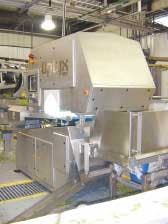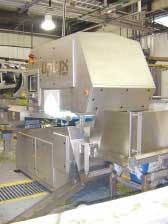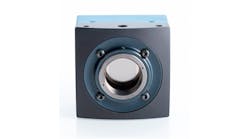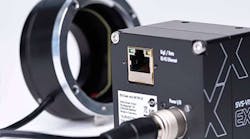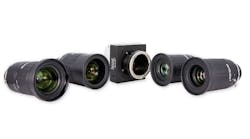VSD: How is Key using OEM peripherals such as frame grabbers, lighting, software, and other off-the-shelf components? In the inspection of food products, especially, how important is each component, more or less, for each application?
Miner: Key Technology builds a variety of vision inspection systems. At the high end, Key is the largest worldwide supplier of high-capacity food-inspection systems, with an installed base of more than 2000 machines. These are typically used for applications such as sorting out defective product and foreign material from products such as green beans and French fries at capacities of up to 25 metric tons per hour (see photo on p. 20).
On these high-end systems, accuracy and throughput are critical, so nearly every aspect of these machines is customized. Key designs and builds cameras, vision engines, lighting systems, and all the mechanical conveying. On lower-cost machines, where throughput is not as critical, we have more applications for OEM products, particularly for two-dimensional/matrix-camera-based applications.
Product presentation and lighting are often the most critical aspects of a successful implementation, so these pieces still tend to be customized. Matrix cameras and frame grabbers are nearly always off-the-shelf because the cost and quality of these components can be excellent. Vision engines are Key-designed for higher-end applications where speed is more important. For most matrix camera systems, commercial engines and PCs are desirable from a cost perspective. We also make use of commercially available vision libraries for image processing.
VSD: What market changes are driving the implementation of new technologies that you choose for these applications?
Miner: Customers in every market are looking for hands-off solutions. They are reducing work force and demanding lines that are as automated and self-regulating as possible. We need components that are consistent part-to-part and extremely stable over time so we can deliver repeatable results 24/7. Also, we are seeing increasing demand for color vision systems. Key has been concentrating on color-based systems for more than a decade, so more companies are approaching us looking for partnership arrangements to take advantage of our experience.
VSD: In which areas do you see the most growth? What are users demanding from you in the design of such systems?
Miner: The main areas of growth are in smaller, less expensive vision systems that are color-based and industrial-hardened. Harsh washdown conditions and extreme temperatures are frequent. Customers also want to tie into existing plant systems, so ease of communication is a must, from Ethernet to various field-bus applications.
VSD: What technologies and components does Key use in these applications?
Miner: Megapixel and larger color cameras are fairly common, with Camera Link being the interface of choice. We typically do not see very high data rates for frame-based cameras, which is an area where we typically cross over to a line-scan camera. CPUs tend to be fairly high-end, ranging from single-board computers to workhorses with large blocks of customizable logic onboard, so we can run proprietary algorithms developed for our larger project lines. Networking is a must. We don't design anything without at least Ethernet today.
VSD: How does Key approach a new application? For instance, does it start with an internal RFP? Is there a list of Key-qualified vendors and integrators?
Miner: The machine-vision market has a few large OEMs selling packaged components and a number of small, often local, integrators using off-the-shelf parts to assemble vision systems for a company in their backyard. Key's business is typically a result of a larger customer—someone with plants in lots of locations, often international—who approaches us because of our worldwide field service and support or because of existing relationships. Sometimes, it's a customer who poured a lot of money into a local supplier and isn't happy with the results.
We typically like to partner with customers who have some understanding of machine vision and a solid understanding of their plant processes and needs. Our typical customer needs rock-stable color inspection in a harsh environment. Our internal applications group will test an application during the quote phase, including test runs and spectrographic analysis. Depending on the product, this will often take place at a customer site to ensure that we are testing to the real standard and have an intimate understanding of the customer's product and process. We then prototype the system and run a factory acceptance test in our plant before installation at our customer's site.
We have a number of vendors that we use for OEM components, but we are often pushing technology limits, so we are always evaluating new components and suppliers.
VSD: Does Key perform its own systems integration or look to outside integrators for support or OEM suppliers for help? If so, what are the criteria for approving an outside source, and what criteria do you look for when selecting an integrator?
Miner: We perform all of our own production and installation. For an OEM supplier, we usually look for leading-edge suppliers that really understand their products. Surprisingly few suppliers routinely demonstrate more than a basic understanding of what they provide. For example, we expect a lighting vendor to supply data on spectrographic output over time and temperature, as well as normalized specifications over a field of view. For some highly customized products such as pick-and-place, we will work with the manufacturer to establish interfaces and workable hand-offs.
VSD: How do you envision the future of imaging in the industries you serve? For instance, what trends will occur in the future to make the systems-integration task easier? What kinds of new applications do you expect to emerge?
Miner: As capabilities increase, some of the standards we deal with are consolidating. For example, Camera Link seems to be dominating the high-speed camera interfaces. That makes it easier for us to mix and match standard designs to substitute camera resolution as needed. In general, communications standards at all levels are improving, which eases our task of interfacing to customer systems.
We see our systems becoming smarter—more self-aware as time goes on. The customer ideal of a 'lights-out' factory is forcing us to continually make our systems more robust and plant savvy, which might mean that instead of setting an alarm buzzer off because of an out-of-spec condition, we e-mail plant maintenance personnel a warning of a condition trending toward out-of-spec. We're making our systems responsive to typical issues, such as field changes in incoming product, without having to bring in an operator to fine-tune a lookup table.
VSD: How will OEM components targeted toward machine-vision applications have to change to successfully meet those emerging applications?
Miner: We're always driving for higher-quality system-level performance. This might mean components that last longer, have some level of built-in redundancy, or can self-diagnose and alert our supervisor CPU to problems. Since we deal with systems that are expected to last for years in harsh environments, we need more than just individual quality, but also line support over a period of years. If we have a component die on us five years from now, we need an upgrade to the latest version with minimum effort or disruption to our customer's process. OEMs who can show that sort of long-term market support are the vendors we team up with.
STEVE MINER is director of R&D at Key Technology (Walla Walla, WA, USA; www.key.net). He was vice president of engineering at SRC Vision before its merger with Key. Miner has a degree in electrical engineering and computer science from the Massachusetts Institute of Technology and has started several successful businesses. Editor in chief Conard Holton talked to him about automated inspection, defect removal, and food production.
